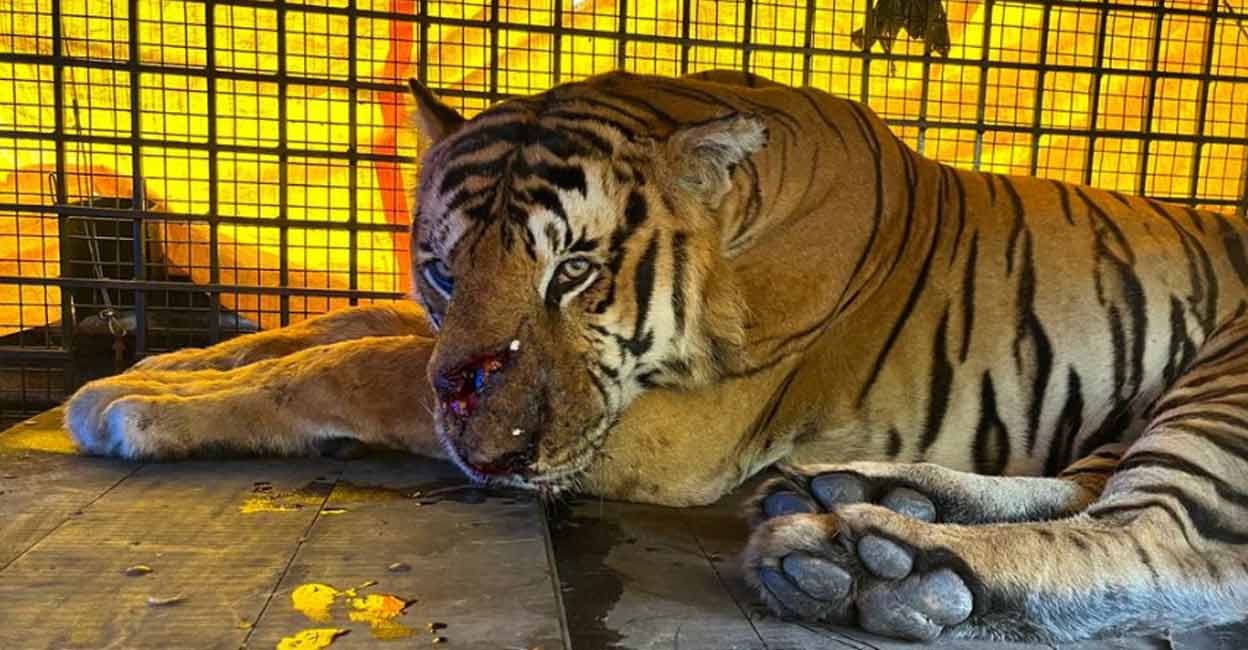Column | Euthanasia for man-eating tigers

Mail This Article
Exploring Wayanad on a chilly New Year's Day was usually refreshing, but this time, it carried an air of unease. Residents were widely gripped by a fear of tigers amid the bustling festive
tourist season, starting from Christmas. Despite the Forest Department capturing the man-eating tiger that killed a dairy farmer in Koodallur through a meticulous combing operation, the people of Wayanad couldn’t rid themselves of the fear it had instilled.
Due to the ongoing tiger scare, 161 parishes under the Mananthavady diocese ended their Christmas festivities early, including moving the midnight mass to 8 pm.
The current conservation approaches are opposed by the Wayanad residents, who strongly demand the killing of all the tigers that prey on humans. Many eyes held a revengeful glare akin to the vengeful spirit displayed by Mohanlal's childhood character in Pulimurugan, grieving the loss of his father to a man-eating tiger.
What strategy can India, the world’s largest democracy, adopt to deal with the popular demands against its fiercely conserved national animal? Let’s delve into a bit of history and the global experience to find an answer.
Days of Tiger Shikar
Before the late 1960s, tiger hunting was legal in India and was a profitable business that contributed significantly to foreign exchange. In 1964, a New York Times report titled 'India Is Stalking the Rupees of Big-Game Hunters' stated that out of the 105 tourist tiger hunters in India, the majority were Americans. They collectively spent a total of $145,000 for a shot at the tiger. According to the report, India's Tourism Department successfully attracted a significant number of affluent hunters who had previously visited Africa by promising that “Tigers provide a thrill that the sluggish African lion can never equal”.
A total transformation occurred in the early 1970s when the reckless approach to acquiring much-needed foreign currency led to the near-extinction of tigers and many other species in India. In response to the situation, Prime Minister Indira Gandhi implemented major policy changes.
Following the Wildlife (Protection) Act of 1972 and the introduction of Project Tiger in 1973, the Government of India banned game hunting altogether.
Subsequently, the Royal Bengal Tiger was designated as the national animal of India.
After half a century, Project Tiger has evolved into a highly commendable and successful initiative to conserve the tiger population. A significant rise in India’s tiger population was reported officially, reaching 3,682 in 2022 from a mere 268 in 1973. The tiger numbers in India have nearly doubled in the first two decades of this century.
Unfortunately, tigers straying from the forest pose a threat to human lives and livestock.

Wayanad, possibly having the highest tiger density in the world according to experts, serves as a classic example. For any conservation effort to succeed with public cooperation, human-animal conflicts need to be avoided, and various models exist across the globe to guide us further.
African Experience
Several African nations have adopted a conservation model showcasing the harmonious coexistence of hunting and conservation. Comparable models are evident in Europe, where residents are permitted to hunt specific animals of designated size and age. These measures aim to regulate animal populations within defined limits to maintain a natural balance.
Namibia, the African country that supplied India with cheetahs and played a role in the revival of the extinct species in Madhya Pradesh’s Kuno National Park, serves as a good example.
The Namibian government allows controlled hunting for a price. For instance, Ozondjahe Hunting Safaris, one of the major hunting outfitters in Namibia, charges $7,013 to hunt a cheetah within their territory. “I am not a hunter. Nor have I ever been. I am a strong supporter of legal, ethical hunting of indigenous wildlife within sustainably managed populations, in large open landscapes. The reason is simple. Well-managed hunting is extremely good for conservation. In many areas, it is essential for conservation,” Dr Chris Brown, ecologist and former Head of the Namibia Directorate of Environmental Affairs, wrote in a policy paper published by the Namibian Chamber of Environment.
Engaging in well-regulated hunts generates significant revenue that can be directed towards supporting local communities and curbing illicit poaching. Despite these potential benefits, the long-term impacts of such hunting activities on wild cat populations remain ambiguous and depend on how they are implemented. According to one of the largest reviews of all research studies on hunting, published by One Earth in 2021, "the interactions between recreational hunting and biodiversity conservation are often context-dependent and necessitate the careful management of positive and negative conservation trade-offs".

In the Indian context, the Namibian model cannot be considered acceptable. Controlled hunting in Namibia is driven by wealthy foreigners willing to pay a significant price for trophies, taking parts of the hunted animals with them. While the funds generated support conservation measures, this approach raises serious ethical and biological concerns. The practice echoes unpleasant colonial times and may potentially encourage rampant poaching in the Indian setting.
Euthanasia as an option
"Human beings are not the natural prey of tigers, and it is only when tigers have been incapacitated through wounds or old age that, to survive, they are compelled to take to a diet of human flesh" to quote from 'Man-eaters of Kumaon' by Jim Corbett, the legendary hunter, and fervent conservationist who was instrumental in establishing the first national park in India.
Typically, tigers aged over fifteen years venture beyond their forest territory and begin preying on humans and domesticated animals. Having suffered severe injuries to its nose, the tiger recently captured in Koodallur, Wayanad, was unable to hunt in its natural habitat.
Well-known naturalist David Raju recently suggested that unless governments can establish safari parks for tigers, generating tourism revenue, it is better to cull tigers aged over fifteen years if they begin preying on human settlements. He pointed out that preserving big cats is a costly affair, and the zoological parks in Kerala already have an ample population of tigers.
Conservation isn't solely about preserving all wildlife at any cost; the European and African experience shows that even hunting can coexist with conservation.

Eliminating an aged, wounded tiger that cannot survive in its natural habitat should be considered an act of euthanasia or mercy killing. It is not directly contrary to conservation. There is no justification for adhering strictly to conservation principles from the 1970s that were framed at a time when tigers were on the brink of extinction in India.
Any government should find it unacceptable to allow a stray animal to prey on its people. Preserving nature through conservation measures should rely on sustainable, scientific models that ensure the well-being of both wildlife and the local population.
(Social anthropologist and novelist Thomas Sajan and US-trained neurologist Titto Idicula, based in Norway, write on politics, culture, economy, and medicine.)


